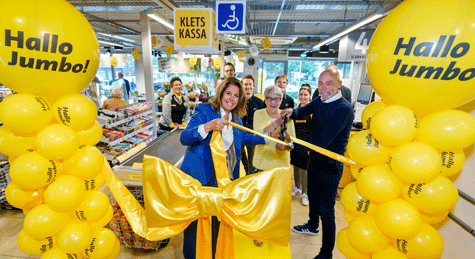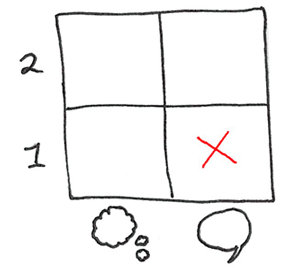The real social media
The algorithmic rabbit holes of Facebook, Instagram, and Snap can isolate us, but could we use both today’s and tomorrow’s digital technologies to connect In Real Life (IRL)?
By Brad Berens
Both in its etymology and our common practice “social media” is oxymoronic, like “jumbo shrimp.” The Latin root socius means ally (or similar words like comrade) and is a shared root for society; media is the plural of medium, which means in the middle or between. In an oddly literal, etymological way, therefore, social media stands between people and prevents them from making contact.

Credit: Jumbo.com
You see it on every subway, bus, and plane, in every coffee shop and restaurant, on park benches, in checkout lines: people stare into their phones, checking Facebook, Snap, Instagram, and that-thing-that-used-to-be-called Twitter, and do not interact with the physical beings around them.
I love public transportation and take it whenever I can. Riding the subway when I visit New York, I often gaze out the window instead of into a screen. Sometimes people look uneasy—in a “did somebody fart?” way—because we’re so accustomed to our elective isolation.
The difference between social media contact and In Real Life (IRL) contact is like the difference between chewing cherry-flavored gum and eating cherries. The gum is available on demand, requires no work, always tastes the same, and has neither pit nor nutrients. Cherries are only around during the warmer months. They vary in taste and quality, can stain your shirt if you’re not careful, have fiber and sugar, and watch out for that pit. Gum is easier but cherries are better.
Jumbo, the Dutch supermarket chain, has now put Kletskassa—or “chat checkout”—lanes into more than 100 of its stores. Lonely people who crave connection can take extra time to chat with the cashier. Kletskassa lanes are the opposite of “15 items or less” (pedantic aside: it should be “or fewer,” damn it) and newer, even-less-humane self-checkout lanes in American markets. According to Grocery Dive:
Jumbo first rolled out the chat checkouts in the summer of 2019 as part of the Dutch government’s campaign to fight loneliness and now positions them, alongside “chat corners” where people can enjoy coffee and small talk, as part of community-building efforts.
Similar chat checkout lanes are emerging elsewhere: in the Canadian Sobeys chain and the French Carrefour chain, where chat checkout is amusingly called Blablabla Caisses or “blah blah blah checkout.”
There are two lessons to pull from chat checkout.
First, as brick-and-mortar retail stores struggle, understanding that some customers come for more than just the goods they’re purchasing is an actionable insight. Although competitive pricing is important, overfocusing on price is counterproductive. This lesson is obvious but still worth stating.
Second, and less obvious, is that Jumbo needed to give permission to its lonely customers to slow down and chat by creating the Kletskassa lanes as a clearly demarcated space for something other than speedy exits. Even extroverts might balk at striking up a conversation with a cashier if another customer is standing in line, tapping a foot and a phone, but not if you’re in the blah blah blah lane.
What does any of this have to do with social media?
With the exception of Tinder, which has the goal of getting people to put down their phones and start, um, interacting after they match, most social media algorithms are designed to be rabbit holes.
But what if we could use technology to indicate when we’re open to chatting with a new person IRL?
This will become trivially easy as Smart Glasses like Apple’s new Vision Pro become our dominant computing devices (which won’t happen for a while).
If you’re looking for a place to sit and enjoy a latte and a morning muffin at your crowded local coffee shop (I’m a Peet’s fanatic, myself), then your smart glasses will provide an information overlay as you look around the room. The guy in the corner tapping away at his tablet might have indicated, “sure, you can sit here, but I’m working. Please don’t talk.” The woman two tables away might have indicated, “I’m happy to chat.” And the two people both furiously typing might have indicated, “yes, we know there’s an extra chair, but please don’t join us.”
Since there are few pleasures so profound as a good quadrant, here’s how that might work:

1 and the cloud at the bottom left indicate, “I’m thinking and want to be alone.”
2 and the cloud at the top left mean, “I’m working quietly, but you can come work here too.”
2 and the word balloon at the upper right mean, “come chat.”
The red X in the bottom right box is there because the person sitting alone and talking to himself is probably somebody you want to avoid because he’s either on a phone call (rude) or mentally ill (sad).
This, by the way, is the simplest visualization. Smart glasses can indicate so much more:
- I’m in a committed relationship, but I still like talking with people.
- I’m single and open; here is my orientation/pronoun information. Please check it before asking me out.
- We have 23 contacts in common across our different networks.
- I’m a huge Star Trek nerd.
- Happy to chat, just not about politics.
- I’m allergic to most perfumes.
- How ’bout them Dodgers?
We don’t actually need digital technology in order to do the basic version of this.
Years ago, my friend David Daniel imagined an analog gizmo that airplane travelers could affix to the back of the seat in front of them that presented two options: “please wake me for refreshments” or “please let me sleep,” like a hotel Do Not Disturb sign.
Likewise, coffee shops could provide laminated signs that say, “please join me” or “working quietly but happy to share this table” for customers to borrow.
Enterprising individuals could make their own signs (although there’s a risk of looking creepy) and bring them along.
Like dogs, we humans are pack animals who thrive on IRL contact with each other. Digital technology that helps us with this is the real social media.
__________

Brad Berens is the Center’s strategic advisor and a senior research fellow. He is principal at Big Digital Idea Consulting. You can learn more about Brad at www.bradberens.com, follow him on Post and/or LinkedIn, and subscribe to his weekly newsletter (only some of his columns are syndicated here).
See all columns from the Center.
August 2, 2023

